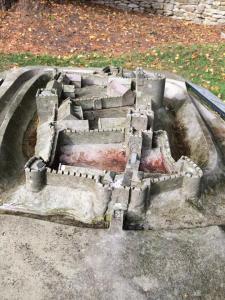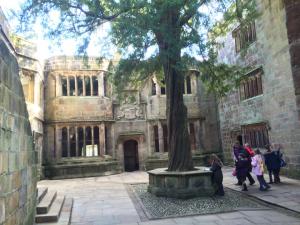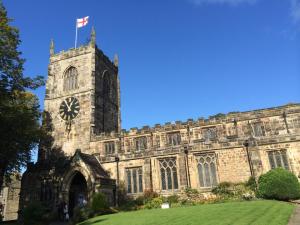“Body of Evidence” was the title of a talk given by Dominic Smee, Richard III’s “body double”, at Leicester University earlier this year. Until recently, one of the great mysteries surrounding the last Plantagenet king of England was the contradiction between the severity of his supposed deformities and his reputation as a soldier, praised amongst others by his brother Edward IV, who was himself considered a paragon of military prowess. Some historians suspected that his deformities were exaggerated or even completely invented by his political enemies, pointing to the fact that reports about them only began to surface after his death, while others argued that it was his military reputation which was exaggerated and that his contemporaries were simply too scared to mention his deformities during his lifetime.
The finding of Richard’s skeleton with its severe scoliosis has reignited the debate. As Philippa Langley, who led the search for the king’s lost grave, succinctly put it when first setting eyes on the royal remains: “How do you fit armour on that?” This was the question scientists and historians tried to answer by dressing scoliosis sufferer Dominic in medieval armour and putting him through his paces. The results were presented in two TV documentaries, a UK version called “Richard III – The New Evidence” and a US version called “Secrets of the Dead – Resurrecting Richard III” – at least, some of them. The purpose of Dominic’s talk at Leicester University was to reveal, based on photos, videos and personal anecdotes, what the producers of the documentaries had chosen to exclude.
The scoliosis and its effects (or not)
He began by showing an x-ray of his scoliosis, which is identical to Richard’s in terms of angle and rib rotation, except that Richard’s scoliosis starts from the 4th vertebra whereas Dominic’s starts from the 3rd vertebra. This means that he has slightly less mobility in his hips than Richard while Richard would instead have had slightly less mobility in his right shoulder. Given how dramatic the curvature looked on the x-ray, it was startling how little it seemed to affect Dominic as he moved around the auditorium or demonstrated the use of a war hammer. Under a t-shirt and light jacket it was all but invisible.
He explained that due to the sideways curvature of his spine the lung capacity on his left side is reduced, but the right side is normal and while he tires more easily than a person without scoliosis, it is not a big issue. The documentaries show him struggling for breath on a treadmill, but at the point when they started filming he had already been running for 20 minutes. According to his orthopaedic surgeon his other internal organs, such as his heart, are not affected by the scoliosis, which was a key reason why Dominic decided not to have corrective surgery.
As I showed in my previous science post, there has been much speculation about Richard being in pain and the impact this may have had on him physically and psychologically, but Dominic didn’t experience any pain during his teens. Now, in his late twenties, he only gets muscle cramps in cold weather conditions or when lifting something heavy, though not enough to need pain killers. He described the pain from a trapped nerve as 10-20 times worse. Unlike Richard he doesn’t have arthritis in his spine, so he was unable to comment on its effect, but this may have been a relatively recent development for the king, who was 32 years old at the time of his death. He would have also been training for armed combat since childhood, which would have strengthened his muscles and helped to support his back.
By contrast, aside from a spell of karate in his teens Dominic led a sedentary lifestyle, so he had to start his knightly training from scratch at age 26. He estimated that he received 40 hours of horse training and 32 hours of weapons training over three months, at an average of two lessons per week, to prepare him for the challenges that were thrown at him in the documentary. The producers actually had a stand-in on hand, but Dominic did so well that they decided to use him all the way.
Customising the armour and unseen research
Because of the sideways curvature of his spine Dominic’s rib cage rests on his hip, so regular armour causes his ribs to rub against the plate, restricting his breathing. The custom-made asymmetrical cuirass, created by Swedish armourer Per Lillelund Jensen from CK45 spring steel, the closest modern equivalent to medieval armour steel, accommodates the curvature and rests on his shoulders instead of his waist. At 62 pounds total weight his armour is also lighter than average to allow for greater agility and to minimise the impact of the asymmetrical weight distribution on his horse. Dominic had brought the cuirass along to the talk and despite the slightly uneven shoulders, which would normally be concealed by the shoulder pauldrons, it looked remarkably “normal”.
1) and 2) Dominic in full armour, and 3) the custom-made cuirass
Dominic gave due credit to his teachers, Dave Rawlings of the London Longsword Academy and Dominic Sewell of Historic Equitation, as he described how he started out learning sword moves from Hans Talhoffer’s medieval fencing manual, but then moved on to other weapons as Richard would have also learned to fight with battle axe and lance, and explained how he and his horse learnt to deal with the asymmetrical weight distribution caused by his scoliosis and how they discovered that the medieval saddle helped him by supporting his back.
He also revealed that they choreographed a number of scenarios to explore how Richard may have died, both on foot and sitting on a vaulting horse, to see how long he could have defended himself against a group of halberdeers. Another experiment involved a re-enactor hitting the top of a sallet with a pole axe, which created a similar imprint in the polystyrene head underneath as the wound on top of Richard’s skull because, due to the gap between sallet and skull, the weapon couldn’t penetrate fully, possibly confirming that “the stroke his Basnett to his head vntill his braines came out with blood”1. Most intriguingly Toby Capwell, Curator of Arms and Armour at the Wallace Collection and the man who got Dominic involved in the research, reenacted Richard’s final cavalry charge to see if he could have covered the 800 or so yards distance in time to kill Henry Tudor before he was attacked by Stanley’s men. Dominic didn’t specify how they worked out the available timespan, but in an interview with Jon Snow of Channel 4 Dr Capwell stated that, if Richard hadn’t killed the standard bearer but gone straight for Tudor, the charge may well have succeeded. Sadly very little of this made it into the US version of the documentary and none of it appears in the UK version, except for a short snippet that shows Dominic playing dead on the floor. As he pointed out, this too was part of the choreography – he hadn’t collapsed from exhaustion, as the programme claimed.
Unseen challenges with borrowed armour
What also wasn’t shown in the documentaries was that, due to time and financial constraints, only the cuirass and leg armour, which were so comfortable that Dominic was able to ride a bicycle in them, were custom made. The sallet, shoulder pauldrons, gauntlets and arming doublet were borrowed from fellow re-enactors and the Royal Armoury, which led to unforeseen complications.
Dominic described wearing a sallet as similar to looking through a letterbox: he could only see his horse’s ears and the tip of his lance, all sounds were muffled except the wind whistling around his head and to take his battle axe out of his belt with gauntlet-clad hands, use it and put it back he had to rely on muscle memory. However, the sallet he wore in the programme was too big and the first time he galloped towards the quintain it slid down until it covered his eyes, so he had to pad out his coif to hold it in place. Similarly, the arming doublet didn’t take account of his scoliosis, so it too had to be padded to keep the armour from sliding or rubbing. The symmetrical shoulder pauldrons kept catching on his asymmetrical cuirass, reflecting his shoulder blades catching on his rib cage underneath, so every time he lifted the lance he had to deliberately push up the pauldrons, which should have risen automatically as he lifted his arms had they fit correctly. He had to try and hold reins and weapons without being able to close his hands because the gauntlets didn’t fit and while the high-backed medieval saddle helped his posture it wasn’t designed to interact with his custom-made armour, so the culet, a piece of armour that’s meant to protect the rider’s bum from weapons while on horseback, was instead driven into Dominic’s bum. Imagine galloping through a field wearing ill fitting plate armour and trying to hit a target with a weapon you’re unable to grip properly – after only 40 hours of training!
The real Richard
Although Dominic didn’t say it, it seems clear that both documentaries, but particularly the UK version, were edited to emphasise his physical limitations, for example filming him when he was out of breath or playing dead, while glossing over the shortcomings he overcame, such as ill fitting armour and lack of experience. The US version is edited differently and its commentary is less alarmist, but both versions blame Richard’s defeat at Bosworth on his scoliosis and his supposedly poor health (a claim at which we look more closely in our post The King In The Lab – Richard III’s Dissolute Diet). Of course, if Dominic’s achievements were more impressive than they appear in the programmes – he spent up to 11 hours a day on horseback – then it should be even less surprising that Richard, with his greater experience and custom-made armour, was able to earn a reputation as a competent warrior.
To explore how and to what extent these “limitations” can be further compensated Dominic has set up the Dominic Smee Armour Fund to raise money for a fully customised suit of armour. He has already added a new piece to his collection – an asymmetrical arming doublet curtesy of Ninya Mikhaila of The Tudor Tailor, which fits under his asymmetrical cuirass without the need for padding – and he will soon be able to purchase his own helmet, vambraces and gauntlets. He is also writing a book about his scoliosis and how his attitude has changed from previously ignoring it to now accepting it. As he commented at the end of the talk, the biggest surprise for him was finding out how much he is actually able to do.
I would recommend Dominic’s talks to anyone who is interested in Richard III. He’s an engaging speaker who, despite his different background, is in the unique position of being able to offer insights based on first hand experience. “Body of Evidence” added many new details to my understanding of the historical Richard and I look forward to any new information Dominic’s research may reveal.
You can find out more about Dominic and his work here:
Channel 4: “Richard III: The New Evidence”
PBS: “Secrets of the Dead – Resurrecting Richard III”
Dominic Smee Armour Fund: “The Arming Doublet”






















